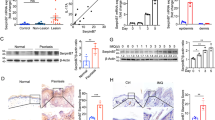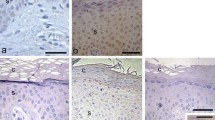Abstract
Skin-derived antileukoproteinase (SKALP, also known as elafin) is an inducible epidermal serine proteinase inhibitor, that we have recently characterized at the protein and DNA levels. SKALP is a strong and specific inhibitor of PMN elastase, and is putatively involved in the regulation of cutaneous inflammatory processes. In order to investigate the role of SKALP in the control of elastase in psoriatic epidermis, we compared SKALP expression in normal skin, and in skin from patients with chronic plaque psoriasis and pustular forms of psoriasis. Epidermal scales and biopsies were collected and SKALP expression was studied at the mRNA level and at the protein level both functionally and immunochemically. In epidermal scales, we found that the levels of both free and total SKALP activity in pustular psoriasis were far lower than in plaque psoriasis. A significant number of pustular psoriasis patients showed latent SKALP activity, which represents the amount of SKALP putatively complexed to elastase. In addition, we found free elastase activity in 25% of the pustular psoriasis patients, indicating a total saturation of epidermal SKALP activity. In epidermal biopsies from pustular psoriasis patients, SKALP activity was significantly decreased compared with those from plaque psoriasis patients. Northern blot analysis did not reveal differences in epidermal mRNA levels between chronic plaque psoriasis and pustular psoriasis. We hypothesize that a reduced amount of epidermal SKALP contributes to an imbalance between elastase and its inhibitor, thereby promoting the formation of epidermal pustules. We suggest that these findings could provide a rationale for the treatment of pustular psoriasis with inhibitors of PMN-derived proteinases, as a new therapeutic modality.
Similar content being viewed by others
References
Kerkhof PCM van de (1986) Clinical features. In: Mier PD, Kerkhof PCM van de (eds) Textbook of psoriasis. Churchill Livingstone, Edinburgh, pp 13–39
Elder JT, Fisher GJ, Lindquist PB, Bennett GL, Pittelkow MR, Coffey J, Ellingsworth L, Derynck R, Voorhees JJ (1989) Overexpression of transforming growth factor in psoriatic epidermis. Science 243:811–814
Baadsgaard O, Tong P, Elder JT, Hansen ER, Ho V, Hammerberg C, Lange-Vejlsgaard G, Fox DA, Fisher G, Chan LS, Voorhees JJ, Cooper KD (1990) UM4D4+(Cdw60) T cells are compartmentalized into psoriatic skin and release lymphokines that induce a keratinocyte phenotype expressed in psoriatic lesions. J Invest Dermatol 95:275–282
Uyemura K, Yamamura M, Fivenson DF, Modlin RL, Nickoloff BJ (1913) The cytokine network in lesional and lesionfree psoriatic skin is characterized by a T-helper type 1 cellmediated response. J Invest Dermatol 101:710–705
Kerkhof PCM van de, Chang A (1989) Migration of polymorphonuclear leukocytes in psoriasis. Skin Pharmacol 2: 138–154
Schalkwijk J, Chang A, Janssen P, Jongh GJ de, Mier PD (1990) Skin-derived antileucoproteinases (SKALPs): characterization of two new elastase inhibitors from psoriatic epidermis. Br J Dermatol 122:631–641
Schalkwijk J, Roo C de, Jongh GJ de (1991) Skin-derived antileukoproteinase (SKALP) an elastase inhibitor from human keratinocytes. Purification and biochemical properties. Biochem Biophys Acta 1096:148–154
Schalkwijk J, Vlijmen-Willems IMJJ van, Alkemade JAC, Jongh GJ de (1993) Immunohistochemical localization of SKALP/elafin in psoriatic epidermis. J Invest Dermatol 100:390–393
Janoff A (1985) Elastases and emphysema. Current assement of the protease-antiprotease hypothesis. Am Rev Respir Dis 132:417–433
Schalkwijk J, Berg WB van den, Putte LBA van de, Joosten LAB (1987) Elastase secreted by activated polymophonuclear leukocytes causes chondrocyte damage in intact articular cartilage: escape from inactivation by alpha-1 proteinase inhibitor. Br J Exp Pathol 68:81–88
Schrijver G, Schalkwijk J, Robben JCM, Assman KJM, Koene RAP (1989) Antiglomerular basement membrane nephritis in beige mice. J Exp Med 169:1435–1448
Takamori K, Yoshike T, Morioka S, Ogawa H (1988) The role of proteases in the pathogenesis of bullous diseases. Int J Dermatol 27:533–539
Briggaman RA, Schechter NM, Fräki J, Lazarus GS (1984) Degradation of the epidermal-dermal junction by proteolytic enzymes from human skin and human polymorphonuclear leukocytes. J Exp Med 160:1047–1042
Wiedow O, Schröder J, Gregory H, Young JA, Christophers E (1990) Elafin: an elastase specific inhibitor of human skin. Purification characterization and complete amino acid sequence. J Biol Chem 265:14791–14795
Wiedow O, Lüdemann J, Utecht B (1991) Elafin is a potent inhibitor of proteinase 3. Biochem Biophys Res Commun 174: 6–10
Sallenave JM, Ryle AP (1991) Purification and characterization of elastase-specific inhibitor. Sequence homology with mucus proteinase inhibitor. Biol Chem Hoppe Seyler 372:13–21
Alkemade H, Kerkhof P van de, Schalkwijk J (1992) Demonstration of skin-derived antileukoproteinase (SKALP) in urine of psoriatic patients. J Invest Dermatol 99:3–7
Alkemade HAC, Jongh GJ de, Arnold WP, Kerkhof PCM van de, Schalkwijk J (1995) Levels of Skin-derived antileukoproteinase (SKALP)/elafin in serum correlate with disease activity during treatment of severe psoriasis with cyclosporin A. J Invest Dermatol 104:189–193
Molhuizen HOF, Alkemade HAC, Zeeuwen PLJM, Jongh GJ de, Wieringa B, Schalkwijk J (1993) SKALP/elafin: an elastase inhibitor from cultured human keratinocytes. Purification, cDNA sequence and evidence for transglutaminase crosslinking. J Biol Chem 268:12028–12032
Saheki T, Ito F, Hagiwara H, Saito Y, Kuroki J, Tachibana S, Hirose S (1992) Primary structure of the human elafin precursor deduced from the nucleotide sequence of its gene and the presence of unique repetitive sequences in the prosegment. Biochem Biophys Res Commun 185:240–245
Molhuizen HOF, Zeeuwen PLJM, Olde Weghuis D, Geurts van Kessel A, Schalkwijk J (1994) Assignment of the human gene encoding the epidermal serine proteinase inhibitor SKALP (P13) to chromosome region 20q12–q13. Cytogenet Cell Genet 66:129–131
Sambrook J, Fritch EF, Maniatis T (1989) Molecular cloning, a laboratory manual, 2nd edn. Cold Spring Harbor Laboratory Press, New York
Streit V, Wiedow O, Bartels J, Christophers E (1993) Metabolism and urinary excretion of elafin, a specific inhibitor of human leukocyte elastase (abstract). J Invest Dermatol 101:422
Wiedow O, Wiese F, Christophers E, (1995) Lesional elastase activity in psoriasis. Diagnostic and prognostic significance. Arch Dermatol Res 287:632–635
Perlmutter DH, Joslin G, Nelson P, Schasteen C, Adams SP, Fallon RJ (1990) Endocytosis and degradation of alpha 1-antitrypsin-protease complexes is mediated by the serpin-enzyme complex (SEC)_receptor. J Biol Chem 265 (28):16713–16716
Author information
Authors and Affiliations
Rights and permissions
About this article
Cite this article
Kujipers, A.L.A., Zeeuwen, P.L.J.M., de Jongh, G.J. et al. Skin-derived antileukoproteinase (SKALP) is decreased in pustular forms of psoriasis. A clue to the pathogenesis of pustule formation?. Arch Dermatol Res 288, 641–647 (1996). https://doi.org/10.1007/BF02505272
Received:
Issue Date:
DOI: https://doi.org/10.1007/BF02505272




